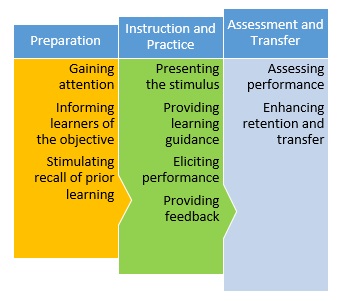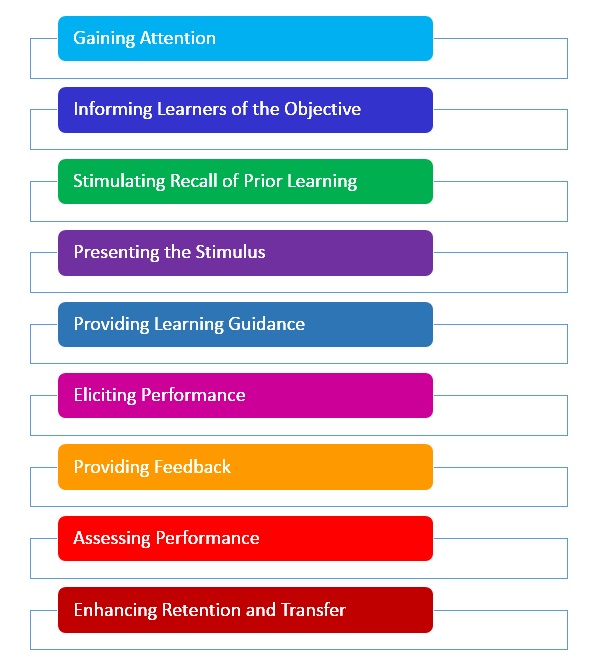Gagne’s Nine Events of Instruction
Robert Gagne was an educational psychologist who created a nine step process called the Events of Instruction. Gagne’s Nine Events of Instruction model helps trainers, educators, and instructional designers structure their training sessions. The model is a systematic process that helps them develop strategies and create activities for instructional classes. The nine events provide a framework for an effective learning process. Each step addresses a form of communication that supports the learning process. When each step is completed, learners are much more likely to be engaged and to retain the information or skills that they are being taught. The steps essentially give designers an outline or prototype to use prior to performing teaching or training activities.
Gagne’s Nine Events of Instruction
- Gaining attention (reception)
- Informing learners of the objective (expectancy)
- Stimulating recall of prior learning (retrieval)
- Presenting the stimulus (selective perception)
- Providing learning guidance (semantic encoding)
- Eliciting performance (responding)
- Providing feedback (reinforcement)
- Assessing performance (retrieval)
- Enhancing retention and transfer (generalization)
The Conditions of Learning
In his book, The Conditions of Learning, Gagne identified the mental conditions for learning. These were based on the information processing model that focuses on the cognitive events that occur when learners are presented with a stimulus. Gagne Nine Events of Instruction are connected to and address the Conditions of Learning. Gagne divides the conditions into two groups; internal and external. Internal conditions are the already established learned capabilities of the learner. Basically, what the learner knows prior to the instruction. External conditions deal with the stimuli that is presented externally to the learner (e.g. instruction provided to the learner). These Conditions of Learning are essential to Gagne’s Events of Instruction. Gagne’s model allows instructional designers to consider the possible internal and external conditions that have an effect on the learning process.
The nine Events of Instruction can be divided into three segments;
Preparation
- Gaining attention
- Informing learners of the objective
- Stimulating recall of prior learning
Instruction and Practice
- Presenting the stimulus
- Providing learning guidance
- Eliciting performance
- Providing feedback
Assessment and Transfer
- Assessing performance
- Enhancing retention and transfer
GAGNE’S NINE EVENTS OF INSTRUCTION
1. Gaining Attention (Reception)
Begin the learning session by gaining the attention of the learners. Ensure the learners are motivated to learn and participate in activities by presenting a stimulus to gain their attention. This can be accomplished by presenting the learners with an introductory activity that engages the learner.
Techniques for gaining learner’s attention include:
- Stimulate learners with novelty or surprise
- Pose thought-provoking questions
- Have learners pose questions to be answered by other learners
- Present an intriguing problem
- Present a new and interesting situation that provokes curiosity
- Present meaningful and relevant challenge
2. Informing Learners of the Objective (Expectancy)
After gaining their attention, inform the learners of the learning objectives to help them understand what they will be learning during the session. State what the learners will be able to accomplish during the session and how they will be able to use the knowledge in the future. This allows the learners to organize their thoughts on what they will learn and help place them in the proper mind set.
Techniques for stating the objectives include:
- Describe what they will be able to do at the completion of the session
- Describe required performance
- Describe criteria for standard performance
- Explain how their learning will benefit them
3. Stimulating Recall of Prior Learning (Retrieval)
Help the learners make sense of new information by relating it to something they already know or something they have already experienced. To accomplish this present the learner with an experience or cue that stimulates their prior knowledge. Make connections between what they are learning, and their previous learning. When people learn something new, it is best to correlate the new information with related information or topics they have learned in the past.
Methods for stimulating recall include:
- Ask if they have any previous experiences with the topic
- Ask questions about previous experiences
- Ask about their understanding of previous concepts
- Give them an example of an experience similar to what they are learning
4. Presenting the Stimulus (Selective Perception)
Present the learner with the new information using learning strategies to provide effective and efficient instruction. Organize and chunk content in a meaningful way. Provide explanations after demonstrations.
Ways to present session content include:
- Organize your information in a logical and easy-to-understand manner.
- Chunk information
- Provide examples
- Utilize multiple delivery methods (e.g., video, demonstration, lecture, podcast, group work)
- Use a variety of text, graphics, figures, pictures, sounds, simulations, etc. to stimulate the senses
- Use a variety of approaches (such as visual cues, verbal instruction, and active learning) to suit people with different learning styles / preferences.
5. Providing Learning Guidance (Semantic Encoding)
Offer the learner guidance by providing coaching on how to learn the skill. Give examples and advise of strategies to aid them in the learning content and of resources available to them. Also, provide guidance using cues, hints, and/or prompts to help them understand and remember what they are learning.
Ways to provide learning guidance include:
- Concept mapping for associations
- Mnemonics to cue and prompt learning
- Role playing for visualization of application
- Case studies for real world application
- Analogies to help knowledge construction
- Graphics to make visual associations
6. Eliciting Performance (Responding)
Let the learner do something with the newly acquired behavior, skills, or knowledge. Provide them with practice activities to activate the learning process. This activity allows the learner to internalize the new information (skills and knowledge) and to ensure correct understanding and application of the knowledge/concepts.
Ways to activate learner processing include:
- Have the learner do something with the newly acquired behavior
- Have the learn demonstrate practicing skills
- Have the learner apply knowledge to a scenario or case study
- Ask questions so that they can show their knowledge
- Ask the learner to demonstrate how to use it
- Have them complete a role playing exercise
7. Providing Feedback (Reinforcement)
After the learner attempts to demonstrate their knowledge, provide immediate feedback of learner’s performance to assess and facilitate learning. This is also a good time to reinforce any important points.
This stage helps reinforcement of a correct answer, gives guidance as to the degree of correctness of the task, and/or provides corrective feedback if the response or behavior is incorrect.
Tips on providing feedback:
- Be positive
- Be objective
- Use first-hand observation
- Deliver focused and concise feedback
- Focus on areas the student can control
8. Assessing Performance (Retrieval)
In order to evaluate the effectiveness of the instructional events, administer a test the learner to determine if the expected learning outcomes have been achieved. Performance should be based on previously stated objectives.
Methods for assessing performance learning include:
- Written test
- Short questionnaires
- Short essays
- Oral questioning
- Other measurement tool to show that they’ve learned the material or skill effectively
9. Enhancing Retention and Transfer (Generalization)
Give the learner resources that enhance retention and transfer of knowledge so that they are able to internalize the new knowledge and enhance his or her expertise. Repeated practice with effective feedback is the best way to ensure that people retain information and use it effectively.
Methods for helping learners internalize new knowledge include:
- Having them summarize content
- Having them generate examples
- Having them create mind maps / concept maps
- Having them create outlines
- Having them create job-aids
- Having them create other types of reference material
Additional Links
Gagnes Nine Events Instruction
Kirkpatricks Four Levels of Evaluation
Reference
Gagne, R., Briggs, L. & Wager, W. (1992). Principles of Instructional Design (4th Ed.). Fort Worth, TX: HBJ College Publishers.
Gagne, R. (1985). The Conditions of Learning (4th.). New York: Holt, Rinehart & Winston.
Gagne, R. (1987). Instructional Technology Foundations. Hillsdale, NJ: Lawrence Erlbaum Assoc.


